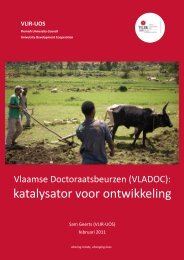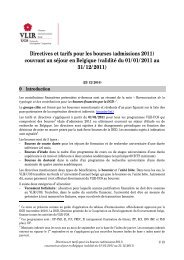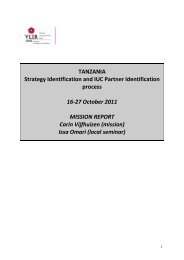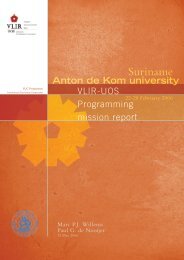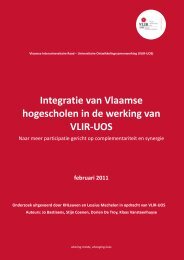Education Sector Development Program - VLIR-UOS
Education Sector Development Program - VLIR-UOS
Education Sector Development Program - VLIR-UOS
You also want an ePaper? Increase the reach of your titles
YUMPU automatically turns print PDFs into web optimized ePapers that Google loves.
<strong>Education</strong> <strong>Sector</strong> <strong>Development</strong> <strong>Program</strong> IV<br />
A major shift from a<br />
system based on input to<br />
outcome orientation has<br />
been achieved.<br />
Technical and Vocational<br />
<strong>Education</strong> and Training<br />
(TVET)<br />
The main objective of the TVET sub-sector is to<br />
train middle level human power and transfer<br />
demanded technologies, and by doing so,<br />
to contribute to poverty reduction and<br />
sustainable development. In this respect,<br />
under the past ESDP I, II, and III significant<br />
achievement was made in increasing trained<br />
middle level human power.<br />
Under ESDP III, the TVET sector has benefited<br />
from significant policy and strategy development.<br />
One major milestone was the development of the<br />
nationwide TVET strategy, which stipulated that<br />
the vision for Technical and Vocational <strong>Education</strong><br />
and Training (TVET) in Ethiopia is to create<br />
competent and self-reliant citizens and transfer<br />
of demanded technologies to contribute to the<br />
economic and social development of the country,<br />
thus improving the livelihoods of all Ethiopians<br />
and sustainably reducing poverty. Furthermore,<br />
a major shift from a system based on input to<br />
outcome orientation has been achieved. Other<br />
major recent events providing policy direction<br />
were the TVET focus direction, the nationwide<br />
education conferences and the reports on<br />
capacity building and manufacturing extension.<br />
It is suggested that under ESDP IV, the reform<br />
of the system initiated under the TVET strategy<br />
will be made operational, while a new emphasis<br />
will be laid on the enhancement of quality. This<br />
will involve implementing an outcome based<br />
training system dedicated to promote trust and<br />
cooperation among stakeholders, as well as<br />
strengthening the role of the TVET system in<br />
becoming an agent in technology acquisition,<br />
accumulation and transfer. With this in mind,<br />
the TVET system is expected to fully contribute<br />
to Ethiopia’s vision to become a middle income<br />
country by the year 2025.<br />
Before indicating the new direction that the<br />
TVET sub-sector will take under ESDP IV, an<br />
analysis of major achievements and challenges<br />
as experienced under ESDP III will be presented.<br />
1. Situation analysis<br />
This section consists of key achievements<br />
obtained under ESDP III and remaining<br />
challenges. In 2008/2009, a revised TVET strategy<br />
was elaborated and adopted. The implementation<br />
of the activities foreseen in the TVET strategy<br />
is well underway. A shift from an input- to an<br />
outcome- based TVET system has been initiated.<br />
In particular:<br />
❚<br />
❚<br />
❚<br />
❚<br />
❚<br />
❚<br />
❚<br />
❚<br />
❚<br />
❚<br />
Many documents showing working<br />
changes as a result of the TVET<br />
strategy were prepared and<br />
presented.<br />
The National TVET Qualifications<br />
Framework is completed and the TVET<br />
Leaders and Trainers Qualifications<br />
Framework (LTQF) is soon to be<br />
finalized.<br />
250 occupational standards were<br />
prepared and completed by 2009/10.<br />
Assessment tools for 211 occupations<br />
were prepared and completed by<br />
2009/10.<br />
Training was given to trainers based<br />
on gap analysis and occupational<br />
standards.<br />
TVET institutions started to train<br />
based on outcomes and occupational<br />
standards.<br />
TVET institutions and enterprises are<br />
implementing co-operative and incompany<br />
training.<br />
TVET institutions are working in<br />
collaboration with micro and small<br />
scale enterprises in extending training<br />
opportunities.<br />
A clear system for technology<br />
capabilities accumulation and transfer<br />
has been established.<br />
180 demanded technologies were<br />
identified, developed and transferred<br />
to users on the basis of value chain<br />
analysis nationwide.<br />
Main challenges<br />
• Society in general and<br />
implementing bodies in particular<br />
have low awareness about the<br />
benefits of TVET<br />
• Stakeholders’ participation in the<br />
management and delivery of TVET<br />
is inadequate<br />
• TVET trainers lack capacity and<br />
competence<br />
• There is lack of capacity by TVET<br />
experts to implement the new<br />
TVET strategy<br />
• The monitoring and evaluation<br />
systems is inadequate<br />
• TVET institutions have low capacity<br />
in adopting and transferring<br />
technology<br />
54






